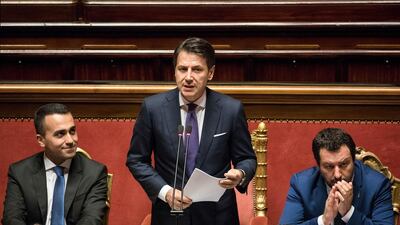Italy’s showdown with Brussels regarding its budget continues to impact the euro and rattle markets. Rome submits on Tuesday what is supposed to be a revised expansionary budget plan.
In an unprecedented move, Brussels last month rejected Italy’s 2019 fiscal budget and gave it two weeks – which come to an end on November 13 – to come up with a more moderate proposal.
But the Italian government, which has indicated that it does not plan to make any changes, risks initiating a long and painful dispute with the European Commission. The tensions could damage the Italian economy and have far-reaching political consequences. Italy's stance is likely to draw criticism from euro zone finance ministers at their monthly meeting on Monday, officials said.
Where are both sides in the budget standoff?
Italian Prime Minister Giuseppe Conte said on Thursday he is “confident” his government will strike a deal with the Commission.
Brussels argues that Italy’s proposed deficit - equal to 2.4 per cent of gross domestic product - is too large to guarantee the reduction in the ratio of debt to GDP. Rome currently accounts for the second-highest deficit in the EU, at around 131 per cent of economic output. The Italian government instead argues that additional expenditures are necessary given Italy’s lack of growth.
How are markets reacting?
While bond markets may have started to stabilise since Standard & Poor’s Global Ratings reaffirmed the country’s credit rating October 26, observers have flagged concerns at the strain on the banking system even at the current levels. The risk premium that had more than doubled since mid-May now stands at over 3 percentage points.
What are the possible outcomes?
Italy’s public debt is a key vulnerability for the European Union. Unlike with Greece in 2010, Brussels and the ECB would not come to the aid of a country that openly defied EU rules should Italy’s stance trigger a run for the exits on the country's mountain of debt. Rome is studying possible measures to support the banks if needed. Italy has an annual GDP of €1.6 trillion and debt of nearly €2.3trn.
_______________
Read more:
Eurozone growth runs out of steam as Italy fears grow
Italy and the EU at loggerheads over budget deficit
_______________
Italy is the EU’s third-largest economy and its wellbeing is important for the entire single-currency bloc. But Brussels is determined to maintain its authority, while at the same time the Italian government does not wish to back off and embarrass itself ahead of the upcoming European elections.
What are the implications for Italy?
The prospect of new financial instability is much dreaded in a country where growth has been stagnant and the unemployment rate among 16 to 24 year olds stands at about 30 per cent.
What are the implications for the euro?
Italian budget concerns continue to weigh on the euro although extra downward pressure has recently been exerted by the news that German Chancellor Angela Merkel will not seek another term in charge after 2021. She has been one of the keenest advocates of holding the euro together and the perceived loss of stability in European politics after she departs has worried investors. The euro has fallen to a 16-month low against the dollar to €1.244 on November 13.

